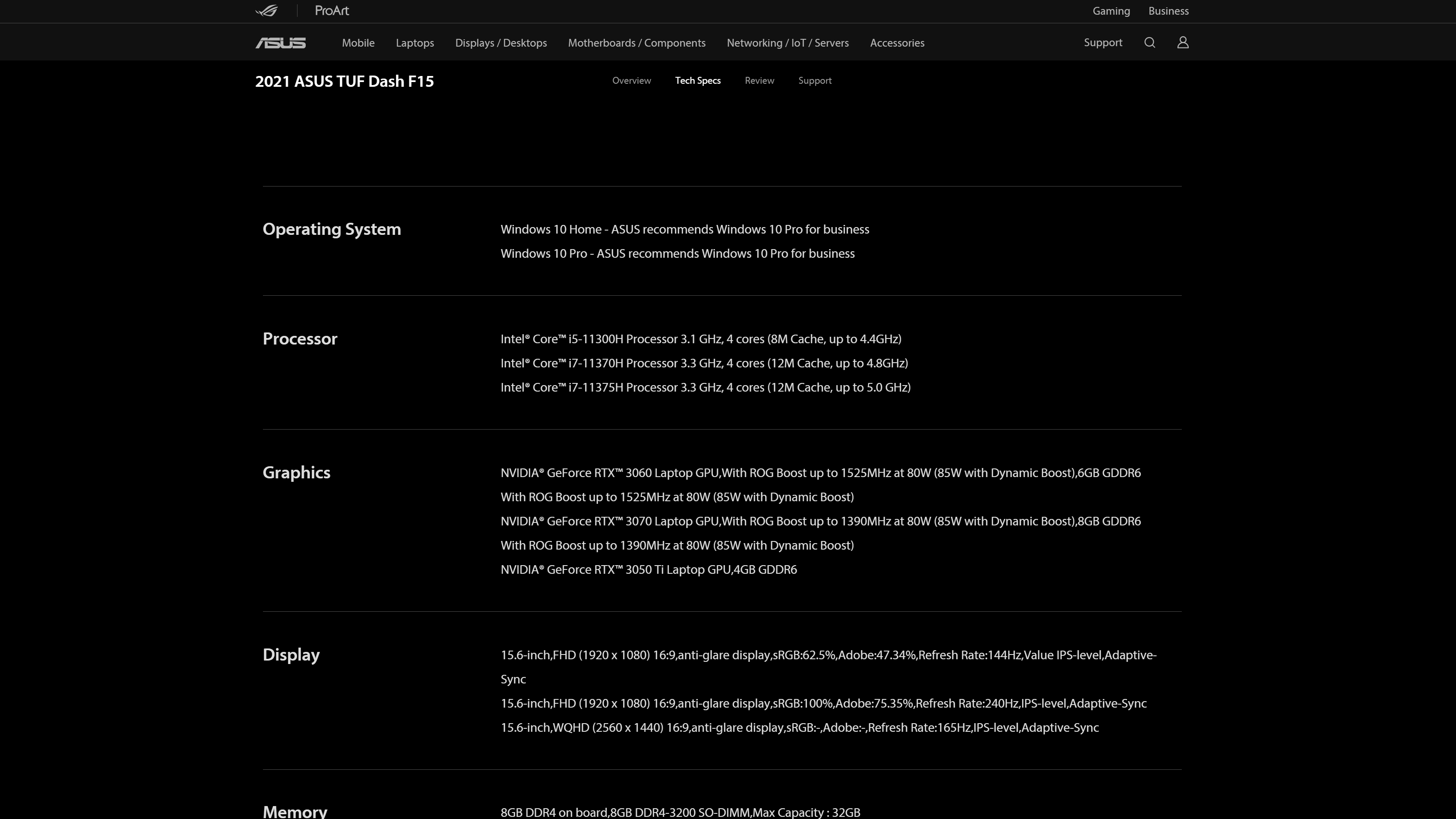GeForce RTX 3050 Ti Listing Implies Ray Tracing on the Cheap

Asus has seemingly confirmed specifications for the mobile GeForce RTX 3050 Ti. As spotted by momomo_us, the graphics card, which Nvidia has yet to confirm, will be available in a cheaper configuration of Asus' TUF Dash 15 gaming laptop.
Early this year, the SKU was listed with an "NVIDIA GeForce GN20-P0," and Asus confirmed to Tom's Hardware that that configuration wouldn't be available in the U.S. Now, the laptop listing reads "GeForce RTX 3050 Ti," sparking further intrigue.
The sole mention of a GeForce RTX 3050 Ti is interesting. "RTX" branding in the model name implies that the graphics card will come with ray tracing support, but Nvidia has never offered ray tracing on a xx50-series SKU before.
For Turing, Nvidia marketed the GeForce RTX 2060 as the entry-level model card for ray tracing. If Asus' listing is accurate, then Nvidia will eventually offer ray tracing across the entire Ampere product stack. However, it might be too early for PC builders to celebrate.
The GeForce GTX 1050 Ti never had a true heir. For reasons unknown, the GeForce GTX 1650 Ti was only available in the mobile form factor. Asus listed the GeForce RTX 3050 Ti for one of its gaming laptops; therefore, it's uncertain if the GPU will make it to the desktop market to compete with the best graphics cards.
Asus only listed the card's memory capacity (4GB of GDDR6). So we still have questions around its other specifications. By today's standard, 4GB of memory will have trouble pushing some of the more demanding triple-A titles and activating ray tracing only only puts more burden on the graphics card.
Historically, Nvidia's xx50-series graphics cards have used the xx7 silicon. For example, the GeForce GTX 1050 Ti and GTX 1650 Ti leveraged the GP107 (Pascal) and TU117 (Turing) dies, respectively. Therefore, it'd make sense for the GeForce RTX 3050 Ti to be based on the GA107 (Ampere) die. The silicon still comes out of Samsung's 8nm furnace but is smaller than the other Ampere dies that we've seen so far.
Get Tom's Hardware's best news and in-depth reviews, straight to your inbox.
The GeForce RTX 3060 features 3,584 CUDA cores, and the GeForce RTX 3050 has been rumored to come with 2,304 CUDA cores. The GeForce RTX 3050 Ti, which would end up in between the aforementioned SKUs, might come equipped with 3,072 CUDA cores then. In that case, the graphics card would probably have 96 Tensor cores and 24 ray tracing (RT) cores. If the 4GB of GDDR6 memory sticks, the GeForce RTX 3050 Ti should employ a 128-bit memory interface. Assuming that the memory is clocked at 14 Gbps, we could be looking at a memory bandwidth up to 224 GBps.
Would this GPU actually even warrant the inclusion of ray tracing? That's debateable, and certainly ray tracing games have shown a tendency to require more memory capacity with RT enabled. However, Nvidia's RTX brand also includes DLSS support. For an entry-level gaming solution, that could prove more beneficial than ray tracing, and at least you still get the option to attempt RT if you want.
A couple months ago, AIDA64 added support for the GeForce RTX 3050, and now, Asus has listed the GeForce RTX 3050 Ti as a graphics card option for its upcoming gaming laptop. It wouldn't surprise us if Nvidia is on the verge of announcing either graphics card.

Zhiye Liu is a news editor, memory reviewer, and SSD tester at Tom’s Hardware. Although he loves everything that’s hardware, he has a soft spot for CPUs, GPUs, and RAM.
-
Udyr ReplyThe GeForce GTX 1050 Ti never had a true heir. For reasons unknown, the GeForce GTX 1650 Ti was only available in the mobile form factor.
1650 and 1650 Super want to know your location.
RTX on a 3050 sounds like a waste, similar to a 2060. The only ray of light on this is that people that didn't get the 2060 could experience the technology (visually, not performance wise) on the "cheap" side. -
hannibal Well maybe people now can now get that $250 that everyone has hoped for ;)Reply
lets see how ”fast” this will be... -
spongiemaster Reply
Raytracing may not be useful at this level, but DLSS absolutely is and that requires the extra rtx hardware as well.Udyr said:1650 and 1650 Super want to know your location.
RTX on a 3050 sounds like a waste, similar to a 2060. -
InvalidError The "raytracing on the cheap" title needs to be taken with a cargo ship worth of salt in the current GPU market situation.Reply
As for 4GB, it should be perfectly workable as long as it is backed by 4.0x16 for the fastest system RAM access possible. I doubt many people expect to play games at anywhere near Ultra on a 50-tier GPU and VRAM requirements go down drastically once you start turning down details. 4GB also makes them completely useless for ETH.
